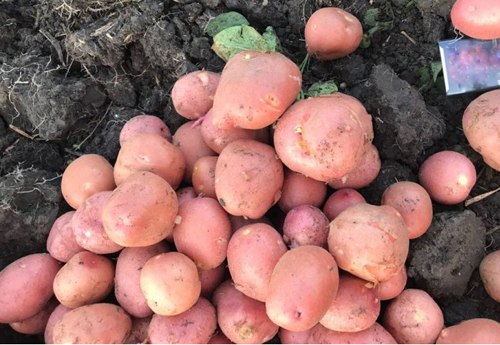Potato variety Red Sonya
Red Sonya is an ultra early potato variety (Solanum tuberosum) for table use. Bred by specialists from EUROPLANT Pflanzenzucht GmbH in Germany. In 2015, three years after filing an application for admission, he was included in the state register of breeding achievements of the Russian Federation. Zoned in two regions of the country: Volgo-Vyatka and North Caucasian. Resistant to mechanical damage, suitable for machine cleaning and transportation over long distances. With proper agricultural technology, it can give two crops per season. Suitable for growing under cover films.

The growing season of potatoes from full sprouting to ripening is 50-65 days, but the first digging can be carried out already on the 45th day.
The plant is tall or medium, leaf type. The main stem is semi-erect. Leaves of medium size or large, closed or intermediate type, are light green, sometimes darker in color. The corolla is medium-sized, with a strong intensity of anthocyanin coloration on the inner side.
6-10 tubers weighing 78-122 grams are formed on one plant. The tubers of the variety are oval, even. The rind is thin, but dense, red in color, smooth to the touch. The pulp on the cut has a yellow color, not prone to darkening when cutting and heat treatment. The eyes are small, shallow.
The marketable yield of Red Sonya during the state tests averaged 174-340 c / ha, which is 28-96 c / ha more than the indicators of Goryanka, Pushkinets. On the 45th day after full germination, during the first digging, it is possible to collect 89-175 c / ha, 37-55 c / ha higher than the Baron results, and during the second digging, on the 55th day of the growing season, - 161-318 c / ha, 48−64 kg / ha more than the Baron norm. The largest amount of the crop was obtained in the Sverdlovsk region - 374 c / ha, 81 c / ha higher than the Baron standard. Marketability is high - 82−97%, keeping quality - 93%.
The taste of potatoes is excellent. According to the EAPR (European Association for Potato Research) classification, it is classified as culinary type B, that is, medium-sized varieties. The tubers are versatile in use, suitable for preparing absolutely any dish, especially well suited for frying, baking and stuffing. After heat treatment, they retain their shape and color, so they look attractive and neat when finished. The starch content in tubers ranges from 13.3-14.6%.
Red Sonya is undemanding to soil and climatic conditions of growth, thanks to which it has spread to many regions of Russia. However, in agrotechnical terms, it is very whimsical and needs special attention. So, in order to obtain a good harvest, the plants should be provided with timely abundant watering, as well as loosening the soil and applying a sufficient amount of fertilizers. Below is a more detailed list of recommendations.

- Before planting, the tubers must be germinated. This will promote better germination and earlier ripening. There is also treatment with growth stimulants, as well as prophylactic agents against diseases and pests.
- Before planting, care should be taken to properly prepare the soil for cultivation. This is plowing, and harrowing, and fertilization. It would be nice to sow the selected area with green manure - they are excellent predecessors of potatoes and, according to gardeners, significantly increase its yield.
- The originator of the variety advises to plant 43 thousand plants per hectare of area, or 430 plants per hundred square meters. Planting pattern 30-32 × 75 cm.
- As mentioned, Red Sonja is sensitive to soil moisture levels. With timely and abundant watering, the yield increases significantly, the number of small tubers decreases. To ensure the best growing conditions, an automatic irrigation system should be installed.
- An important point is to carry out standard agrotechnical techniques during the growing season of plants. This includes loosening the soil and hilling, weeding, preventive treatment against pests and diseases, as well as feeding, but we will talk about it below.
- It is necessary to maintain crop rotation. Do not plant tubers in an area where nightshade crops have previously grown, this can lead to disease damage to the plants, and, consequently, to a decrease in yield.
The originator of the variety indicates the recommended fertilization rates. However, do not forget that the dosage must be adjusted depending on the characteristics of your soil.
- Nitrogen fertilizing should be applied in limited quantities. Their increased content in the soil slows down the development of tubers and accelerates the growth rate of green mass.
- Phosphate fertilizers are used at the rate of 100 kg / ha.
- Potato fertilization is carried out in the amount of 200-250 kg / ha.
- Magnesium is added in a standard or slightly increased dosage, typical for a particular type of soil.
Red Sonya is highly resistant to cancer, cyst nematodes, viruses A and Y, common scab. Medium resistant to black stem. According to the All-Russian Research Institute of Phytopathology, it is moderately susceptible to late blight by tops, tubers are less susceptible to this disease.
A feature of the variety is its rapid development at the beginning of the growing season, due to which the first crop can be harvested quite early. Despite its relatively small age, this species has spread widely across the territory of Russia and has acquired a considerable number of positive reviews. It is especially appreciated for its high yield, undemandingness to weather conditions and soils, excellent taste, excellent presentation and good keeping quality. Also, tubers are resistant to mechanical damage, making them suitable for machine harvesting and transportation.
A clear drawback of Red Sonya is considered to be the exactingness of plants to care, especially sensitivity to soil moisture, but a skilled gardener can easily cope with this nuance. According to potato growers, the disadvantage is also the heterogeneity of tubers in size and their relatively small number in one nest.








